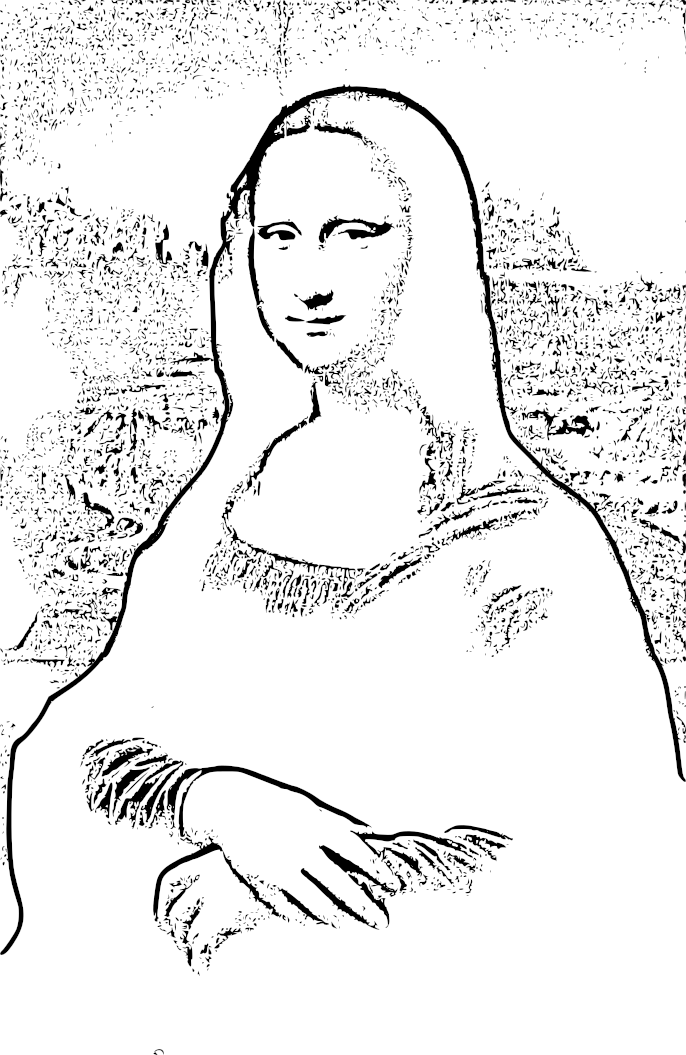Art: The Mona Lisa
Leonardo Da Vinci's Mona Lisa
Perhaps the most famous painting in the world, the Mona Lisa has inspired a lot of admiration and speculation.
In 1502, merchant Francesco del Giocondo commissioned Da Vinci to paint a portrait of his wife Lisa. Da Vinci worked on it for about ten years, refining his techniques in portrait painting, and somewhat idealizing his subject.
Da Vinci also developed many scientific and engineering designs. From age 12-15, he studied in a school focusing on the arithmetic useful for merchants. Later, he apprenticed in a studio led by a skilled sculptor, goldsmith, painter, architect, and engineer where practice and experience were more valued than theory. "One thing is certain: Leonardo's systematic curiosity combined with the 'studio culture' acquired in Florence, obliges him to defy tradition, taking each question back to its very origins - when he is not inventing a new question."[*]from Leonardo Da Vinci: The Rhythm of the World, by Daniel Arasse, Translated from the French by Rosetta Translations, Copyright © Editions Hazan, Paris 1997; Translation copyright © 1998 William S. Konecky Associates, Inc. This is a good example of first-principles reasoning.
Most of his ideas are preserved in his "studio books" - books updated daily and containing everything an artist or artisan might find helpful for the future (including quotes, sketches, memories, technical recipes, etc.).[*]"Journaling" or other routine writing can be a powerful aid in learning and growing.
Some of his studies combined curiosity, creativity, and playfulness. For example, he thought the pitch of a musical note was related to how fast the air beats back and forth, so "he coats the wings of a fly with honey and, observing that the note produced by this fly in flight is lower, he attributes the phenomenon to the lower speed with which the ballasted wings are beating the air."[*]from Leonardo Da Vinci: The Rhythm of the World, by Daniel Arasse, Translated from the French by Rosetta Translations, p. 95, Copyright © Editions Hazan, Paris 1997; Translation copyright © 1998 William S. Konecky Associates, Inc.
Da Vinci brought together observation and theories, abstract reasoning and concrete engineering, that had grown apart over prior centuries: "Experience is never wrong; only our judgment of it is wrong because it expects alien things from its power", "all our knowledge follows our sensitiveness"; but also "In nature, nothing happens without a cause; understand the cause, and you will not need to experience it" and "O students, study mathematics and do not build anything without foundations" and "Where none of the mathematical sciences nor any of those which are based on mathematical sciences can be applied, nothing is certain"[*]from Leonardo Da Vinci: The Rhythm of the World, by Daniel Arasse, Translated from the French by Rosetta Translations, p. 86, Copyright © Editions Hazan, Paris 1997; Translation copyright © 1998 William S. Konecky Associates, Inc.
I am well aware that, because I am not a scholar, some presumptuous people will think that ... my ignorance of letters prevents me from expressing myself on the subjects that I want to develop. But in order to be developed, my subjects require experience more than the words of others.[*]The entire quote is:
I am well aware that, because I am not a scholar, some presumptuous people will think that they can find fault with me and accuse me of ignorance. Bunch of ignoramuses themselves! They do not know that I would be able to reply to them like Marius to the Roman patricians: 'Those who take credit for the work of others do not want to give me credit for mine.' They will say that my ignorance of letters prevents me from expressing myself on the subjects that I want to develop. But in order to be developed, my subjects require experience more than the words of others. And experience having been the mentor of those who write well, I too also choose it as my mentor and will call upon it in any case.
- Leonardo Da Vinci[*]from Leonardo Da Vinci: The Rhythm of the World, by Daniel Arasse, Translated from the French by Rosetta Translations, p. 36, Copyright © Editions Hazan, Paris 1997; Translation copyright © 1998 William S. Konecky Associates, Inc.
This image © 2022 TALLabs using a  Creative Commons Attribution-NonCommercial-ShareAlike 4.0 International License
Creative Commons Attribution-NonCommercial-ShareAlike 4.0 International License
Original Image is in the public domain, available from many sources.
Heavily edited to be a black and white line drawing rather than a color photo.
≪ First ∥ < Previous ∥ ↑ Art ∥ ColoringBook home ⇑ ∥ Next > ∥ Last ≫
